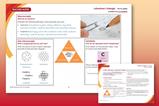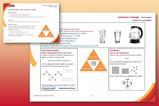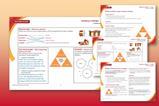Investigate conservation of mass with two experiments exploring the concept
This video presents two experiments, the first is the reaction of magnesium with oxygen and the second is the reaction of calcium carbonate with hydrochloric acid.
Chapter titles: 00:09 Introducing conservation of mass; 01:29 Reaction of magnesium and oxygen; 04:31 Reaction of calcium carbonate with hydrochloric acid; 05:54 Calculating the change in mass; 07:20 Open and closed systems.
Download additional resources
Supporting resources booklet including pause-and-think questions with answers, teacher notes, intended outcomes, follow-up worksheets and structure strips. Plus technician notes and integrated instructions. Editable versions of all worksheets, results tables and the intended outcomes are provided.
Teacher notes
Full teacher notes are available in the supporting resources booklet, including ideas for how to use this video and the supporting resources as part of your teaching.
Notes on running the practical experiments
Two practical experiments are included in the video:
- the reaction of magnesium with oxygen
- the reaction of calcium carbonate with hydrochloric acid
Technician notes and integrated instructions are offered for both experiments.
The reaction of magnesium with oxygen takes around 30–45 minutes, depending on the competence of the class. To fit both activities into one hour in the laboratory it is possible to run both experiments concurrently. Once the crucible is being heated over a roaring blue flame in the first experiment, learners can begin the calcium carbonate with hydrochloric acid reaction. You should be able to complete the reaction in the conical flask before the magnesium has fully reacted. Learners can measure change of mass and clear away their glassware while waiting for the crucible to cool.
Procedure for the reaction of magnesium with oxygen
1. Take a piece of magnesium about 10–15 cm long. Twist it into a loose coil.
2. Put the magnesium inside the crucible and place the crucible with the lid on a mass balance. Record the total mass of the magnesium, crucible and lid.
3. Set up the Bunsen burner on the heat resistant mat with the tripod. Place the pipe clay triangle over the tripod, ensuring that it is secure. Place the crucible containing the magnesium in the pipe clay triangle and put the lid on.
4. Light the Bunsen burner and begin to heat the crucible. It is best to start with a gentle blue flame, but you will need to use a roaring flame (with the air hole fully open) to get the reaction to go.
If you are going to complete the reaction of magnesium with oxygen and the reaction of calcium carbonate with hydrochloric acid concurrently, begin the second procedure here. You must make sure you continue to monitor the crucible and Bunsen burner.
5. Once the crucible is hot, gently lift the lid with the tongs a little to allow some oxygen to get in. You may see the magnesium begin to flare up. If the lid is off for too long then the magnesium oxide product will begin to escape. Avoid this.
6. Keep heating and lifting the lid until you see no further reaction.
7. Turn off the Bunsen burner and allow the apparatus to cool.
8. Place the crucible with lid containing the product onto a mass balance. Record the total mass of the crucible, lid and product.
Procedure for the reaction of calcium carbonate with hydrochloric acid
1. Measure out 20 cm3 of hydrochloric acid in a measuring cylinder.
2. Place the 20 cm3 hydrochloric acid into a 250 cm3 conical flask.
3. Place this onto a mass balance. While the conical flask is still on the mass balance, add 2–3 marble chips to the top-pan. Record the total mass of the flask, acid and marble chips.
4. Add the marble chips to the conical flask.
5. Gently swirl the flask.
6. Record the mass after 3 minutes (or before if there is no more fizzing).
Real-world contexts
- Watch this video to see how Sharlotte, a technical services chemist working in the cosmetics industry, applies conservation of mass to the ratios needed to make formulations.
- Link conservation of mass to glowsticks and the splitting of water to make hydrogen as a fuel and explore further with the activities provided.
- Learners can make their own honeycomb and use it as a way to explain what happens when a product is given off to the surroundings.
- Use these videos to get students apply their knowledge to explain to Antoine Lavoisier how conservation of mass would have applied to his experiments. The first video introduces Lavoisier’s study of combustion and the composition of air, the second shows his work on the conservation of mass in more detail using specific examples.
Key terms
Learners will need to have a clear understanding of the following scientific terminology:
- conservation of mass
- reactant
- product
- state
- gas
- formula
An example Frayer model for the term ‘conservation’ is included in these resources. You can find more examples, and tips on how to use Frayer models in your teaching here.
Prior knowledge
Learners should be familiar with the particle model of matter from their 11–14 learning. They should be able to describe how the arrangement of particles changes as a substance moves between different states.
Learners should also be able to use the periodic table to identify symbols for elements and suggest formula for compounds. Learners should be confident writing word and symbol equations;
There are some questions included which ask learners to balance equations and add state symbols. Depending on where conservation of mass occurs in your scheme of work your learners may not have come across this yet. Adapt the questions to make them relevant to the stage and level that you are at.
Some of the challenge tasks require knowledge from other topics. It would be useful for learners to be able to recall the products of acid base reactions, in particular the general equation:
metal carbonate + acid → a salt + water + carbon dioxide
Common misconceptions
Learners sometimes get unconvincing results when heating magnesium in a crucible. It is worth evaluating what they have done as there are several reasons why their results may be disappointing:
- the magnesium oxide product may escape as they lift the lid
- not all the magnesium may have reacted (the product may still look a bit grey rather than white)
- they may have prodded the product with their splint so not all of it got weighed (more common than you might expect)
- not taring the balance correctly when measuring the mass
- having the magnesium coiled too tightly so that not all of it reacts
Some learners think that gases have no mass and that substances in their solid state have a greater mass than in their liquid form, confusing density with mass. Use carefully structured demonstrations to address these misunderstandings before introducing chemical changes that appear to violate the law of conservation of mass. Some examples of demonstrations can be found in the article How to teach conservation of mass.
Diagnostic multiple-choice questions are a great way to explore learners’ reasoning behind their answers. Best Evidence Science Teaching resources provide a great starting point to explore their ideas about conservation of mass. Learners are given a question and multiple plausible explanations for an observation. They then choose and justify which explanation they agree with. You can also provide learners with thought experiments and ask them to provide their own explanations (see the thinking questions resource). Read more about diagnostic questioning and access Best Evidence Science Teaching resources on the topic of particles and structure.
Downloads
Conservation of mass: supporting resources
Handout | PDF, Size 0.48 mbConservation of mass: integrated instructions
Editable handout | PowerPoint, Size 0.37 mbConservation of mass: technician notes_1
Handout | PDF, Size 1.01 mbConservation of mass: pause-and-think questions
Editable handout | Word, Size 0.12 mbConservation of mass: intended outcomes
Editable handout | Word, Size 0.11 mbConservation of mass: follow-up worksheet
Editable handout | Word, Size 0.12 mbConservation of mass: structure strips
Editable handout | Word, Size 0.11 mbConservation of mass: printable results tables
Editable handout | Word, Size 0.11 mbFrayer model: conservation
Editable handout | PowerPoint, Size 49.94 kb
Additional information
Real-world contexts added by Ian McDaid.


Practical videos | 14–16 years

Videos of core practical experiments for flipped learning, remote teaching or revision
- 1
- 2
- 3
- 4
- 5
 Currently
reading
Currently
reading
Conservation of mass
- 7
- 8
- 9
- 10
- 11
- 12
- 13
- 14





















































No comments yet